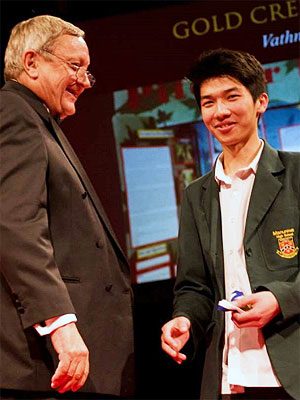2010 | Vathna Am
Manurewa High School

Vathna has been awarded a Gold CREST for his project:
“Pitcher Perfect (Nepenthes ventricosa)”
Supervising teacher: Mrs. Fenella Colyer
Summary of his project:
Vathna aimed to investigate the anti-microbial potential of Nepenthes ventricosa’s pitcher fluid. The objectives are to test the effect of N. Ventricosa’s pitcher fluid on different types of microorganisms, to identify the different types of bacteria that are present in N. Ventricosa’s pitcher fluid and to determine if there were any antibiotic substance produced by the N. ventricosa plants or the bacteria that live inside the pitcher fluid. The purpose of Vathna’s investigation was to find some possible applications of Nepenthes plant’s enzymes and/or bacteria in terms of human health and medicine, or antibiotics for other animals
The project involved four, related, experiments: Each experiment was derived and developed based on the results of the previous experiment.
- The first experiment, called “Filter Paper Experiment”, involved small filter paper discs being soaked with N. Ventricosa’s pitcher fluid, then placed on an agar plate that contained only a single strain of cultured microorganisms, i.e. Staphylococcus epidermidis, Lactobacillus casei, Saccharomyces cerevisiae and bread mould.
- The second experiment, called “Wells Experiment”, was similar to the “Filter Paper Experiment” but instead of using filter paper discs, wells/holes were made in the agar and filled with N. Ventricosa’s pitcher fluid.
- The third experiment, called “The Spectrophotometer Experiment” involved growing microorganisms in broth solutions containing N. Ventricosa’s pitcher fluid. The broth solutions were then compared using the spectrophotometer.
- The fourth experiment, called “Identifying N. Ventricosa’s Pitcher Bacteria”, analysed the 16S rRNA gene of bacteria that are found in N. Ventricosa’s pitcher fluid
Based on the results from the experiments, Vathna concluded that N. ventricosa’s pitcher fluid had no significant anti-microbial effect on any of the micro-organisms that were used in his project. There were no significant death zones/clearance zones around the filter paper discs or the wells that contained N. ventricosa’s pitcher fluid. Therefore, his overall conclusion suggested that there is no anti-microbial activity in N. Ventricosa’s pitcher fluid. However, Vathna’s extensive background research showed that other research has been done on these Nepenthes plants- with different results! They suggest that the pitcher fluid of Nepenthes plants does have antibiotic activity and hence are worth looking at medical applications to which this discovery can be applied.i
In addition to investigating the effect of N. Ventricosa’s pitcher fluid, two different types of bacteria were discovered inside N. Ventricosa’s pitcher fluid. From analysis of their 16S rRNA gene, they were identified as belonging to the genera Pseudomonas and Chryseobacterium. Further research into these bacteria suggested that they might be beneficial to N. ventricosa plants, because they secrete enzymes that could possibly contribute to the property of the pitcher fluid, i.e. in terms of antibiotic activity and digestive property.
Vathna has identified that future prospects of his project could be to determine the types of enzymes that are present in other N. ventricosa plants and determine their roles. Also, to investigate whether the same types of enzymes are present in other species of Nepenthes plants. In addition, the bacteria that were found inside N. Ventricosa’s pitchers could be further analyzed bydetermining where they come from and how did they get into the pitchers. This could also lead to investigating whether these bacteria are present in other N. ventricosa plants from other countries or environments, and if they are also present in other Nepenthes species.
